Chapter 7: Membrane Structure and Function
1/53
Name | Mastery | Learn | Test | Matching | Spaced |
|---|
No study sessions yet.
54 Terms
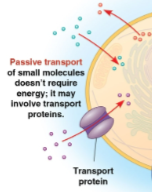
Passive transport
The transport of small molecules from areas of high to low concentration that does not require energy
May require transport proteins in a cell membrane
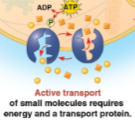
Active transport
The transport of small molecules from areas of low to high concentration that does require energy and a transport protein
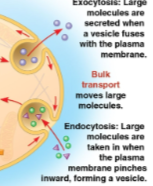
Bulk transport
The transport of large molecules as a form of active transport that utilizes exo- or endocytosis
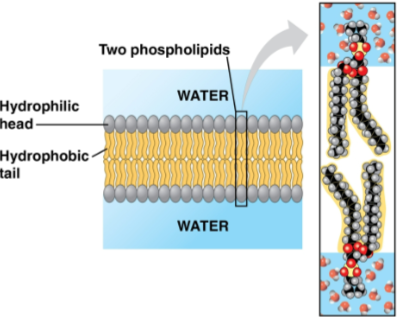
Membrane
Cellular substance comprised of phospholipids and proteins with some carbohydrates
Hydrophobilc phospholipid tails remain on the inside of the bilayer
Hydrophilic heads remain on the outside of the bilayer toward the cytosol and extracellular fluid
Amphiphile
A molecule that contains hydrophobic and hydrophilic regions, such as phospholipids
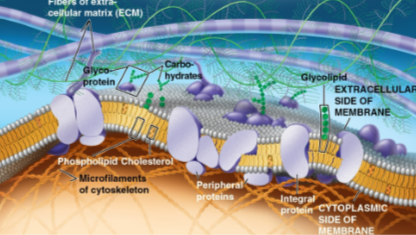
Fluid mosaic model
A model of the membrane as a mosaic of protein molecules bobbing in a fluid bilayer of phospholipids
Proteins typically form groups that carry out common functions
Most lipids and some proteins can move sideways within the membrane
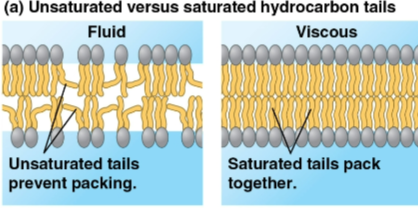
Membrane solidification
Occurs as temperatures cool around a membrane depending on the types of lipids present
More unsaturated fatty acids have higher fluidity than saturated fatty acids
Lowers membrane function through higher packing of molecules — but too fluid membranes do not support protein function
Addressed by some animal behaviors such as hibernation or migration
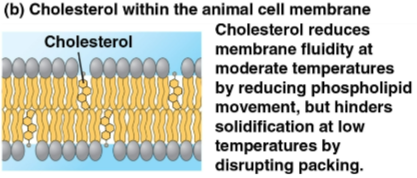
Cholesterol
Membrane component in animal cells that can affect membrane fluidity
Warmer temperatures lead to restriained movement
Cooler temperatures prevent tight packing
Lipid composition
Depends on the environmental conditions of an organism
Extremely cold environments are more conducive to higher unsaturated fats in the membrane
Seasonal changes can occur such as in winter wheat’s increased levels to prevent solidification
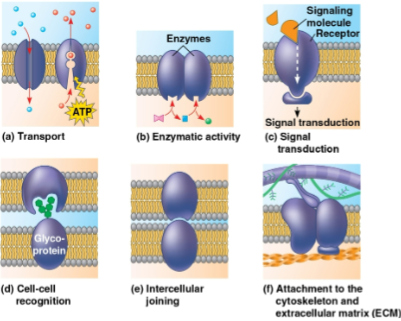
Membrane proteins
Proteins held in place via the cytoskeleton or materials outside the cell that function in:
Transport
Enzymatic activity
Signal transduction
Cell-cell recognition
Intercellular joining
Attachment to the cytoskeleton and extracellular matrix
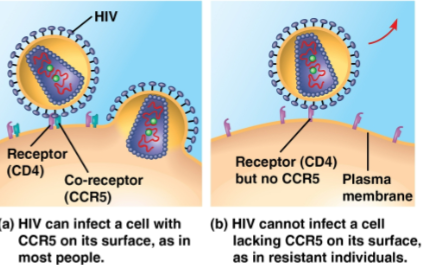
HIV
A disease that enters immune cells by binding to a cell-surface protein and co-receptor
Individuals without the receptor are immune, so drugs are in development to mask the receptor and block entrance in nonimmune individuals
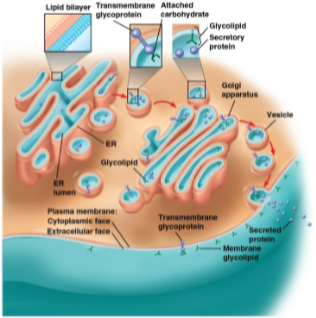
Cell identification
Performed through the binding of molecules on the surface of the membrane; these molecules include glycolipids and glycoproteins for identification markers
Selective permeability
Plasma membrane property that allows substances to cross more easily than others as part of material control
Dependent on the lipid bilyer and specific transport proteins contained
Hydrophobic molecules
Nonpolar molecules that dissolve in the lipid bilayer and pass through the membrane easily; includes hydrocarbons and gasses like CO2 and O2
Hydrophilic molecules
Polar molecules where passage through the membrane is impeded; includes sugars, water, and ions
Requires transport proteins that enable faster transport
Transport proteins
Proteins that function in the transport of hydrophilic molecules across the cell membrane, includes:
Channel proteins (tunneling proteins)
Carrier proteins (polymorphic proteins)
These proteins are molecule-specific, affecting overall selective permeability alongside the membrane
Channel proteins
Proteins that have a hydrophilic channel that certain molecules or ions can use a tunnel
Carrier proteins
Proteins that bind to molecules and change shape to shuttle them across the membrane
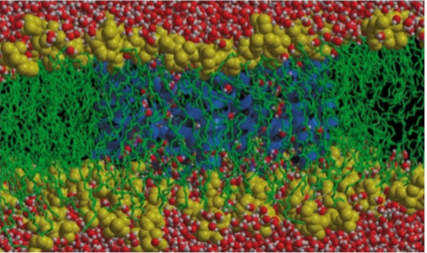
Aquaporins
Channel proteins that greatly increase the rate of passage of water molecules
Over 3 billion pass through per second
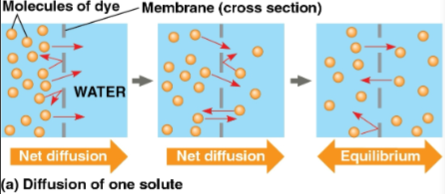
Diffusion
The movement of particles of any substance so that they spread out evenly into the available space
Generally directional until equilibrium is reached
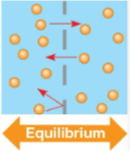
Dynamic equilibrium
State of diffusion where as many molecules cross the membrane in one direction as in the other
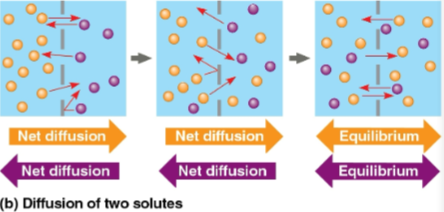
Concentration gradient
The region along which the density of a chemical substance increases or decreases
Substances diffuse down these, unaffected by the concentrations of other substances
Passive transport
Transport of substances that requires no cellular energy expidenture
Potential energy represented by concentration gradient
Rate of diffusion depends on membrane permeability
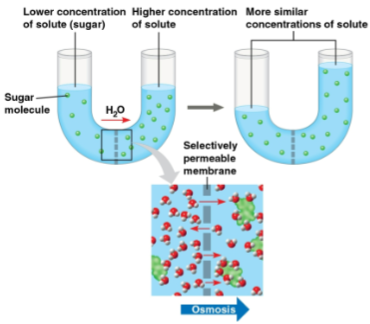
Osmosis
The diffusion of free water across a selectively permeable membrane
Water molecules diffuse to regions of lower to higher solute concentration until equilibrium is reached
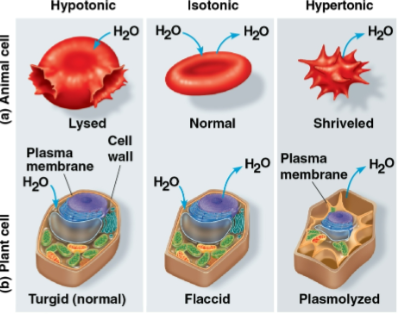
Tonicity
The ability of a surrounding solution to cause a cell to gain or lose water
Depends on the concentration of solutes that cannot cross the membrane relative to the inside of the cell
Water will be attracted to higher concentrations of solute, which can lead to water going in or out of each cell
Extreme hypo- or hypertonicity can cause problems for cells without walls
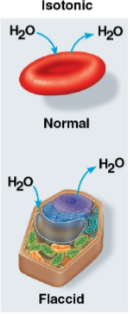
Isotonic
Solution where solute concnetration in a solution is the same as that inside the cell
No net water movement is done across the membrane
Volume remains stable in this solution
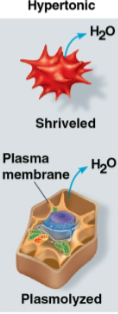
Hypertonic
Solution where the solute concentration is greater than that inside the cell
Net water movement goes outside of the cell to the solution
Cells may shrivel and die as they lose water
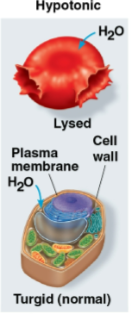
Hypotonic
Solution where the solute concentration is less than that inside the cell
Net water movement goes to the inside of the cell from the solution
Cells may swell and lyse (burst) as they gain water
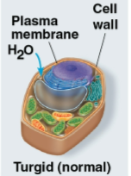
Turgid
Term for a normal plant cell in a hypotonic environment that contains more water
These cells swell until the inelastic wall exert a pressure on the cell, signaling a firm and healthy state
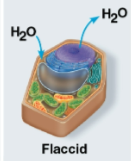
Flaccid
Term for a plant cell in an isotonic environment with less water
No net movement of water occurs, and plant cells will become limp causing wilting
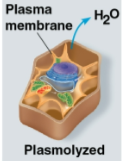
Plasmolyzed
Term for a plant cell in a hypertonic environment with low levels of water
Water moves out of the plant cell, causing the membrane to pull away from the cell wall causing potential death
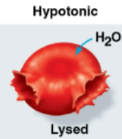
Lysed
Term for an animal cell in a hypotonic environment with too much water
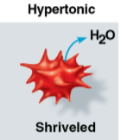
Shriveled
Term for an animal cell in a hypertonic environment with too little water
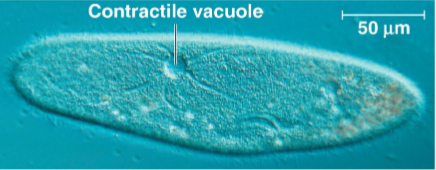
Osmoregulation
The control of solute concentration and water balance
Paramecium have a contractile vacuole to pump excess water out of the cell due to their hypotonic environment
Bacteria and archea in hypersaline environments have mechanisms to retain water
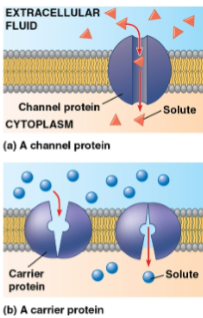
Facilitated diffusion
Diffusion where transport proteins speed up the passive movement of molecules across the plasma membrane
Does not require energy
Includes transport (channel, carrier) proteins
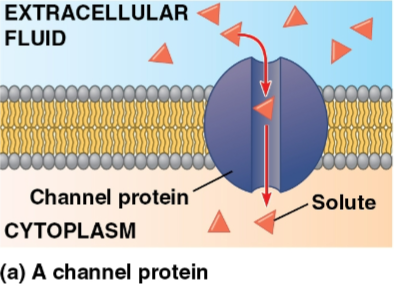
Channel proteins
Transport proteins that provide a corridor for a specific molecule or ion to cross the membrane
Aquaporin
Channel protein that facilitates the diffusion of water
Ion channel
Channel protein that facilitates the transport of ions
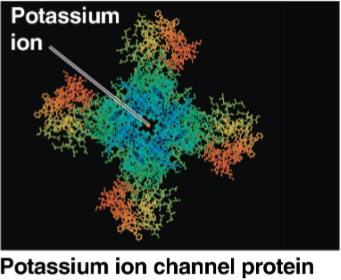
Gated channels
Ion channels that open or close in response to a stimulus
Potassium ion channels open in response to electrical stimulus in nerve cells
Others open in response to chemical stimulus, or the binding of a specific substance to the protein
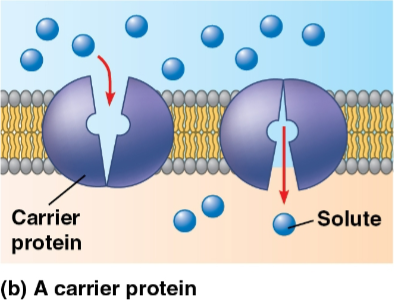
Carrier proteins
Proteins that undergo a substle shape change that moves the solute-binding site across the membrane
Can be triggered by the binding and release of the transported molecule
Substances are moved down the concentration gradient with no energy input required
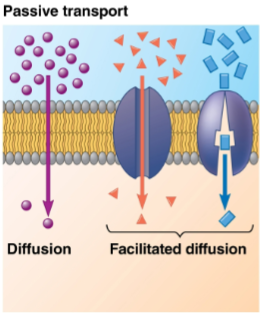
Facilitated diffusion
A passive method of transport that requires no energy due to the molecules only moving down their concentration gradient
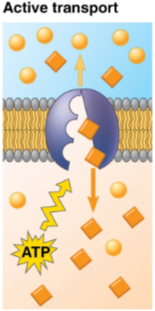
Active transport
Transport that requires energy — usually in the form of ATP hydrolysis — to move substances agains their concentration gradient
Requires carrier proteins specifically
Allows cells to maintain solute concentrations that differ from their environment
Membrane potential
The voltage across a membrane created by differences in the distribution of positive and negative ions across a membrane
Electrochemical gradient
Two forces that drive the diffusion of ions across the membrane that ions diffuse down:
Chemical force (the ion’s concentration gradient)
Electrical force (the effect of the membrane potential on the ion’s movement)
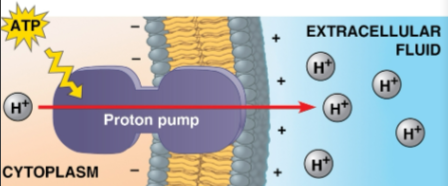
Electrogenic pump
A transport protein that generates voltage across a membrane, storing energy that can be used for cellular work
Animals have the sodium-potassium pump
Plants, fungi, and bacteria have the proton pump that transport H+ ions out of the cell
Cotransport
Transport that occurs when the active transport of a solute indirectly drives transport of other substances
Downhill solute movement may couple to uphill transport of another substance against its own concentration gradient
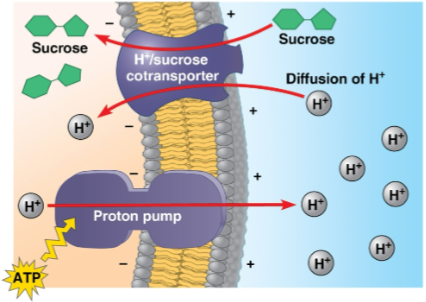
Proton pump
Pump present in plants that generate an H+ gradient across the cell membrane
An H+ cotransporter allows sucrose to be coupled to its active transport into the cell, enabling its transport around a plant body
Sodium-potassium pump
Pump present in animals that transport Na+ out of the cell to maintain the electrochemical gradient while using ATP in the process
Sodium in waste is reabsorbed to maintain a constant level in the body
Drinking concentrated salt and glucose solutions can enable recovery from a rapid, life-threatening loss of sodium too fast for reabsorption
Vesicles
Separated sections of membrane for large molecules like polysaccharides and proteins to cross the lipid bilayer
Smaller molecules and water are transported through proteins or the layer itself instead
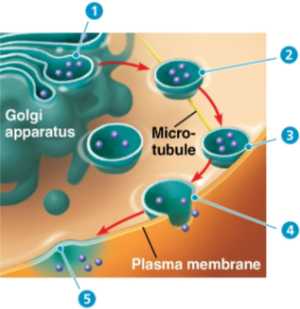
Exocytosis
Process where transport vesicles migrate to the membrane, fuse with it, and release their contents outside the cell
Secretory cells like the pancreas can export products like insulin via this
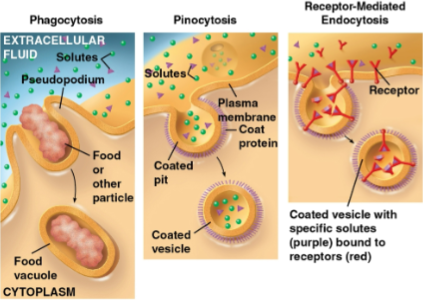
Endocytosis
Process where macromolecules are taken into the cell in vescles through a pocket formed and deepened by the membrane that is eventually pinched off; includes
Phagocytosis (cellular eating)
Pinocytosis (cellular drinking)
Receptor-mediated endocytosis
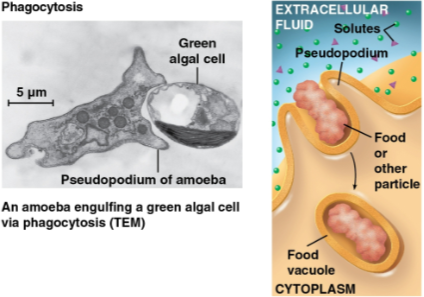
Phagocytosis
Form of endocytosis where a cell engulfs a particle by extending pseudopodia around it and packing it in a membranous sac called a food vacuole
This food vacuole then fuses with a lysosome for digestion
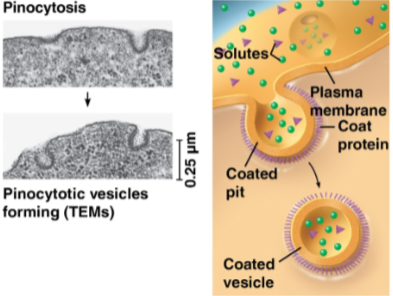
Pinocytosis
Form of endocytosis where a cell takes up extracellular fluid via small vesicles; this is nonspecific for substance transport and any solutes are taken into the cell
The inner side of vesicles formed from the plasma membrane are coated with coat proteins
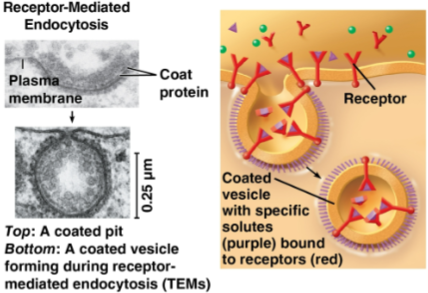
Receptor-mediated endocytosis
Form of endocytosis where vesicle formation is triggered by a solute binding to a receptor
Receptors bound to specific solutes from the extracellular fluid are clustered in coated pits that form coated vesicles
Emptied receptors can be recycled into the plasma membrane by the same vesicle
Used to take in cholesterol within particles called low-density lipoproteins (LDLs) — lack of receptors can lead to hypercholesterolemia, building up in blood vessels